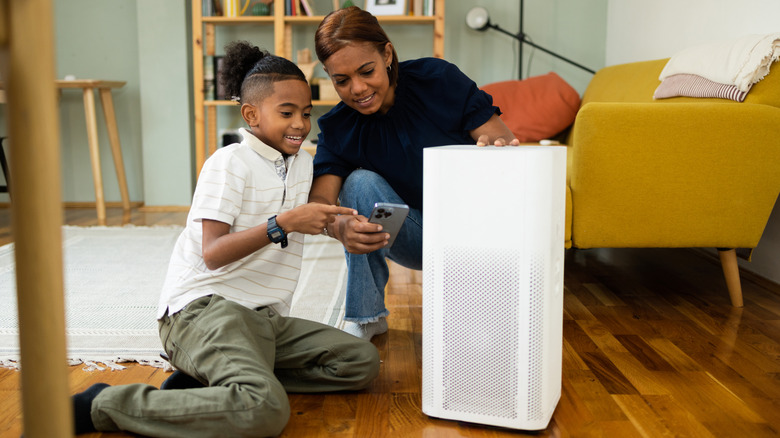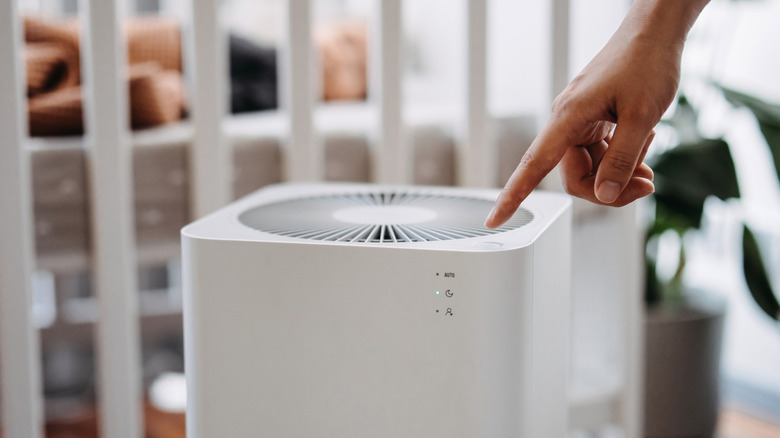The Best Air Purifiers For Wildfire Smoke To Help Protect Your Lungs
Does it seem like you're hearing about devastating wildfire outbreaks more often? There's a reason: Wildfires are occurring more frequently, such as the January 2025 ones in California that caused deaths and damage. (At least $20 billion was passed along to insurers, as reported by Reuters). In fact, according to a 2022 study in Frontiers in Remote Sensing, wildfire incidents have consistently risen globally, based on nearly 20 years of forest loss records.
Beyond the immediate destruction that wildfires cause, they produce copious amounts of smoke, too. Even if you live hundreds of miles from a wildfire, the smoke may infiltrate your community and pollute the air in your home. That's bad news for your lungs, since wildfire smoke contains numerous pollutants that you don't want in your body.
Floating around in wildfire smoke can be anything from harmful acids and chemicals to deadly carbon monoxide and biological waste particles, according to the United States Environmental Protection Agency (EPA). As particulates enter your nose and mouth, they can gain access to your lungs and settle there. When that happens, you might be at risk of life-threatening respiratory or systemic responses like triggered asthma attacks, heart attacks, or carbon monoxide poisoning (per the American Lung Association).
Unfortunately, you can't stop wildfire smoke from wafting to your town. However, you can keep the air fresher in your home by investing in the best air purifier for the reduction of smoke-created odors and particulates.
HEPA and MERV criteria for wildfire smoke air purifiers
There are a few considerations when determining which air purifier to purchase to keep your home freer from wildfire smoke toxins and smells. The first of those considerations is the filtering capability of the purifier. After all, the filter is your main line of defense against all those airborne contaminants. Wildfire smoke contaminants and particulates can vary from relatively large to microscopic.
The EPA warns that around 90% of those particulates are less than 2.5 microns, which makes them too tiny for many types of air purifiers to capture. As a result, those particles can slip back into the air and fuel potential health problems for you and other members of your household. This is why it's essential for you to know whether or not an air purifier can handle ultra-fine particulates. One type of air purifier filter to look for is a high-efficiency particulate air (HEPA) filter. As the EPA notes, some quality HEPA filters can scrub the air of particulate matter as small as 0.3 microns.
The fastest way to find out how "low" an air purifier can go is to check out its minimum efficiency reporting value (MERV) rating. The highest MERV rating is 16, which means that if the air purifier is running at optimum levels to keep your indoor air cleaner, it can filter 95% of even the tiniest airborne pollutants.
Other considerations for determining the right air purifier
Even if you purchase an air purifier with a high MERV rating, you won't get the full benefits if it can't purify the air in your space. Accordingly, you'll need the square-foot dimensions of your room to confidently determine which air purifier can scrub the air in your living areas. You'll use those dimensions to measure against each purifier's clean air delivery rate (CADR), which shows how fast the machine can circulate air. ENERGY STAR suggests picking an air purifier with a CADR of at least two-thirds of the square footage of the room where it will operate. For instance, an air purifier with a CADR of 200 would be a possibility for a 300-square-foot room.
Another way to determine which air purifier to choose is to pay attention to the promised air changes per hour (ACH) capacity. An ACH of five or above is recommended for workplaces to maintain a healthy indoor air quality level, per the U.S. Centers for Disease Control and Prevention (CDC). This is much stricter than the minimum guide of 0.35 ACH that's mentioned by the EPA as acceptable for residential spaces. Nonetheless, it gives you an ACH target range to base your decision. Finally, consistently perform routine maintenance on your air purifier to ensure that it's working properly at all times.


